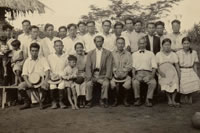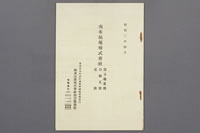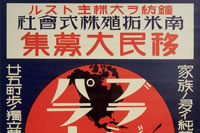Development of the Amazon
Attraction of Japanese immigrants to the Amazon
The Amazon region experienced a boom rubber economy from the late nineteenth century until 1914. In 1897, the Brazilian Legation in Japan held a conference in Tokyo to discuss the possibility of attracting Japanese emigrants to the Amazon region to harvest rubber. The Japanese Legation in Brazil at the time, however, strongly opposed the project, claiming that as the Amazon was considered to be the toughest region in Brazil owing to the equatorial climate and plagues, that because rubber harvesters would be forced to work knee-deep in muddy swamps in intense heat, nobody other than natives in the region could bear working under such adverse conditions without damaging their health.
After emigration to Brazil began, the Japanese Embassy and Consulates in Brazil occasionally cautioned emigrants not to be cajoled into becoming rubber harvesters.
Amazon Kudari
In 1905 (in 1907 according to another story), Japanese immigrants, however, crossed from Peru to Bolivia over the Andes and down to the Amazon for the first time, in order to work in rubber plantations. Those Japanese immigrants were called "Amazon kudari" or "Peru kudari" ("those who had come down the Amazon", or "those who had come down from Peru"), and the number of them are said to have reached between 400 and 500 people by the last half of the 1910s. These people cultivated vegetables and operated a shop in various regions of the Amazon.
In 1922, a judo practitioner Mitsuyo Maeda (known as the "Conde Koma" or "Count Koma") who had travelled from the United States around Central and South America to Brazil, settled in the city of Belem in the Amazon and became a local celebrity as a judo instructor. Afterwards he played an important role in Japanese development projects in the Amazon through personal connections with leading figures in the State of Para that he had made.
Gratuitous grant of land to foreign countries by the State Government
The Amazon rubber economic boom did not last long in 1910s. Natural rubber from plantations in South and Southeast Asia in which rubber plants seeds were used secretly taken from the Amazon by the British in 1876, dominated the global market,. This delivered a major blow to the local economy of the Amazon which depended heavily on rubber harvesting.
In these situations, the two States of Para and Amazonas found a path to the development through attracting foreign immigration, and the Government successively made concessions (gratuitous grant on the conditions that, after the land was surveyed, a tract should be selected and demarcated within the specified number of acres by the prescribed date). The U.S. Ford Company secured a concession of 1,500,000ha acres and launched a development project in 1928.
The Japanese Embassy believed that concentration of Japanese immigrants in São Paulo and surrounding states could be the cause of anti-Japanese sentiments, and that the Japanese should seek opportunities for development in other regions. In 1924 Ambassador Shichita Tazuke dispatched Secretary Ryoji Noda to survey the Amazon.
-
 Hisae Sakiyama and settlers in Maues
Hisae Sakiyama and settlers in Maues -
Original materials
Japanese Government representatives in Brazil cautions on rubber plantations

-
 Vila ----slash-and-burn forest clearing
Vila ----slash-and-burn forest clearing
Nanbei Takushoku Kabushiki Gaisha (South America Colonization Company Limited) (State of Para)
Hachiro Fukuhara survey team
After inspecting a cotton growing situation in the northwestern regions of Brazil in 1925, Yasuhei Ashizawa, an agronomist, who came to Brazil as nonregular staff of the Ministry of Foreign Affairs to carry out agricultural surveys, visited the State of Para along with a study abroad student, Hideo Nakano, dispatched by Kanebo Textile Company (Hereafter referred to as "Kanebo") with a letter of introduction written by Japanese Ambassador Shichita Tazuke for him, to the then Governor of Para, Dionysio Bentes. Ashizawa was tasked with delivering the reply of Governor Dionysio Bentes, including the offer to conclude an agreement on a concession of 500,000ha (to be selected within 1 year) for the establishment of a Japanese settlement.
On receiving a telegram from Tazuke, the Government decided to carry out a survey to select tracts at the expense of Kanebo. The field survey was carried out by a survey team under leadership of Hachiro Fukuhara, a director of Kanebo, from May 1926 to 1927. Fukuhara's team found suitable tracts in the Acara River basin and met with the Governor to obtain consent for the gratuitous grant of approximately 500,000ha of land and the selection of suitable tracts in three areas within the state.
Establishment of the Acara Colony
On March 26, 1928, Giichi Tanaka, Prime Minister and Minister for Foreign Affairs, invited influential economic leaders to the Foreign Minister’s official residence to have a round table conference on projects for cotton cultivation and emigration and settlement in the Amazon region. As a result of the conference, a preparatory committee was established to create a company for these purposes. With funds provided principally by Kanebo, the Nanbei Takushoku Kabushiki Gaisha (South America Colonization Company Limited) was founded on August 11 (with a capital of 10 million yen).
Fukuhara was nominated as director of the company. Immediately after the company was founded, he left Japan and reached Belem in October. In December, he concluded an agreement in his own name to receive the concession of state-owned land in Acara, Monte Alegre and 3 other tracts in the state, established an overseas affiliate company (Companhia Niponica de Plantacao do Brasil (Japan Plantation Company of Brazil)) and assigned the agreement to the company.
The headquarters of the Acara Colony was established in Tome-Acu and the first set of emigrants settled in September who consisted of 43 families and 9 persons leaving their family home, 189 persons in total.
Settlers leaving the plantations one after another
A main product originally cultivated by Nanbei Takushoku Kabushiki Gaisha (South America Colonization Company Limited) was a cacao tree, which is a long-term crop and will not bear any fruit until it has become at least four years old, so the settlers began cultivating vegetables to sell in Belem in order to make a living. They formed the Acara Vegetable Union in 1931 to market products jointly. But they found it hard to make a living, and 61 families of the 202 families who settled during the first three years, left the colony.
Attempts to grow cacao upon which the company counted failed because they did not have the knowledge required for tropical agriculture. In addition, the mining venture which the company made a last-ditch effort to implement also met with failure. Consequlently the Nanbei Takushoku Kabushiki Gaisha (South America Colonization Company Limited) faced financial difficulties and in April of 1935 reduced their business and withdrew from the management of the colony, and the director Fukuhara returned to Japan. From then onwards the colony, thus, was placed under the autonomous administration of the settlers themselves and the Acara Agricultural Cooperative, to which the Acara Vegetable Union was reorganized, practically implemented the administration. For several years after an outbreak of virulent malaria in 1936, settlers left the colony one after another after the harvest time for rice until the end of each year. Between 1935 and 1942 the 374 families consisting of 2,104 persons settled in the colony, while 263 families consisting of 1,603 persons left there and only 98 families (483 persons) remained.
Acara Colony during the war
When it was announced that Brazil had broken off diplomatic relations with Japan in January 1942, the assets of the overseas affiliate company Companhia Niponica de Plantacao do Brasil (Japanese Plantation Company of Brazil Limited) and the Acara Agricultural Cooperative were seized and placed under the control of the State Government. The Acara Colony became an internment camp for people from Axis countries in the Amazon region, to which camp Japanese and Germans were replaced from further up the Amazon River. These Japanese were forced to labor in road construction.
Emergence of the pepper millionaires
The Acara Colony remained under the control of the State Government even after the war. The Acara Farmers Fellowship Association, formed by young and middle aged settlers, solicited the State Government and at the end of 1946, and successfully took a right to directly trade back to the agricultural cooperative. In September 1949, the Acara Colony was renamed the Tome-Acu Colony. Pepper was brought into the region from Singapore by the Nanbei Takushoku Kabushiki Gaisha (South America Colonization Company Limited) before the war and under the guidance of the cooperative, its cultivation spread rapidly with the use of commercial fertilizers and agrichemicals in the 1950s. The global market price of black pepper began to jump higher in 1952, because after Indonesian independence, pepper fields in the country were converted to rice fields to satisfy its domestic demands, and the prices reached a peak between 1953 and 1954. Black pepper came to be known as "black diamonds" and the so-called "pepper millionaires" began to appear among those who successfully cultivated pepper. Pepper prices suddenly plummeted in 1957, but 7% of the world's black pepper was still produced by about 200 families in the Amazon at the beginning of the 1960s.
-
Articles in newspapers / magazines
-
Books
-
 Nanbei Takushoku Kabushiki Gaisha (South America Colonization Company Limited) prospectus
Nanbei Takushoku Kabushiki Gaisha (South America Colonization Company Limited) prospectus -
 Nanbei Takushoku Kabushiki Gaisha (South America Colonization Company Limited) recruitment poster for emigrants
Nanbei Takushoku Kabushiki Gaisha (South America Colonization Company Limited) recruitment poster for emigrants











